All photos courtesy Vanleles Diamonds.
Vanleles Diamonds — focused on producing jewelry sourced from ethical mining — is the first-ever female-owned African fine jewelry brand.
Living and working all around the world has allowed Vania Leles to develop an edge in her work, drawing from her experiences to shape Vanleles Diamonds into a global luxury brand. “Growing up, I studied in between Guinea-Bissau and Portugal, returning to Africa during breaks to travel around the continent with my family,” Leles says. “Upon graduating from NOVA University Lisbon, I moved to London to learn English and became a social worker. I changed careers after being discovered by a modeling scout, and lived and worked as a model in Paris and New York for a few years.”
Leles’ ties to her African heritage are evident in her designs. “Then came that fateful day when I decided to join the jewelry world,” Leles says. “All these events and influences are reflected in details of the Vanleles collection. Some people expect my jewelry to be tribal or ethnic, but it is a combination of my memories of Africa and my experiences traveling throughout the world and living in Europe.”
Leles is no stranger to the world of luxury. While working as a model, she was inspired by the fine jewelry on set, and connected this to her home in Africa. “Around 2003, I was modeling on a shoot with fine jewelry when someone on the set told me that all precious and many semiprecious stones can be found in Africa,” Leles explains. “Intrigued, as I am from the West African nation of Guinea-Bissau, I did some research. I discovered that at that time, there were no African haute-jewelry designers working with these materials native to their continents.”
With this in mind, Leles set out to begin her own company. “This was enough for me to decide that I would establish the world’s first female-founded African high jewelry house,” Leles says.
Leles’ breakout into the world of jewelry was not immediate. “When I told my mother about my plans, she suggested I get 10 years of experience before launching my own company,” Leles reflects. “This seemed like a long time, but I agreed, quitting modeling and enrolling in classes on gems, design and business at the Gemological Institute of America.”
Leles then traveled to New York City, learning and graduating from the Gemological Institute of America. Heeding her mother’s advice, Leles spent over a decade working and learning from world-renowned fine jewelry brands GRAFF, De Beers and Sotheby’s. To launch the jewelry business she had dreamed about since her modeling days, London’s New Bond Street, the heart of the international fine jewelry world, was a clear-cut choice for the location of Vanleles Diamonds flagship atelier. “I came here over 20 years ago to learn English and never went back.”
Vanleles Diamonds offers a variety of jewelry styles, including rings, earrings, necklaces, and bracelets, each crafted by skilled jewelry makers. Leles explained that her goal is to allow the wearers of her jewelry pieces to feel “empowered, happy, and with a knowledge that we created their jewelry in the most transparent and ethical way possible.”
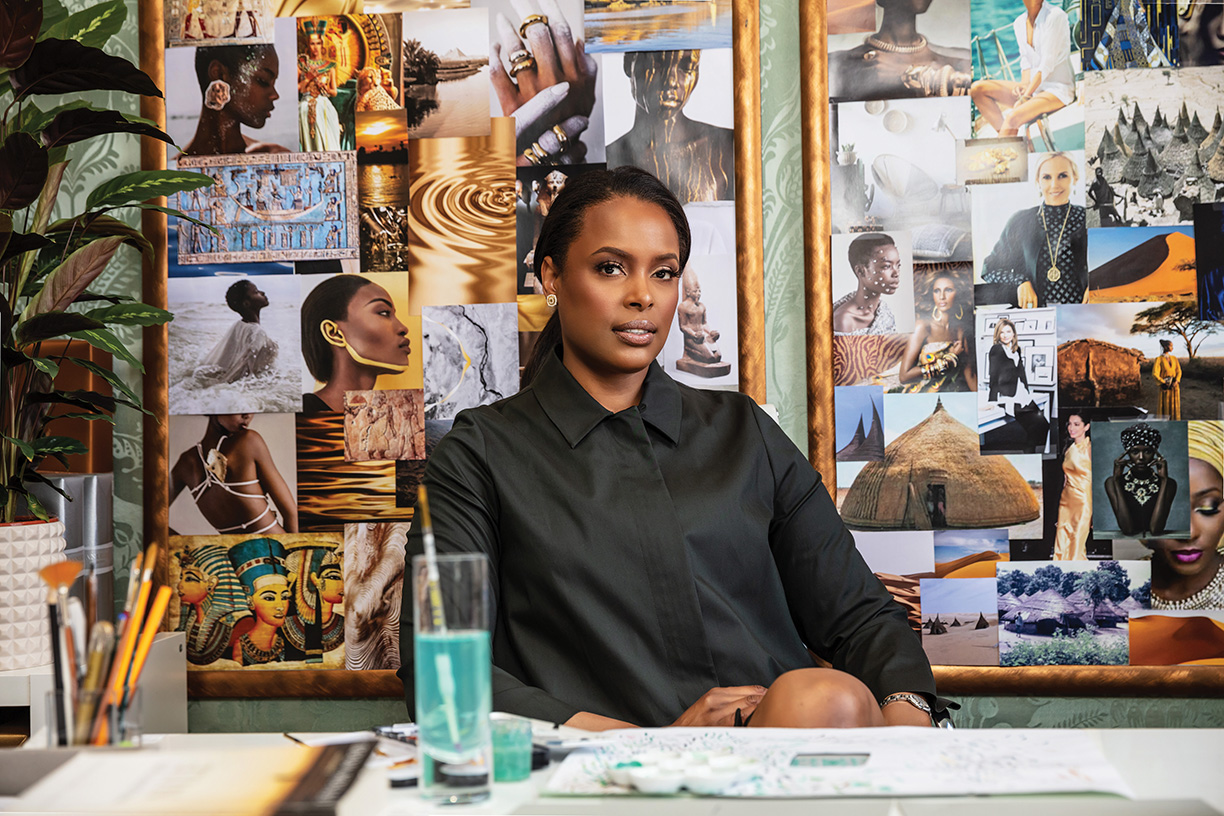
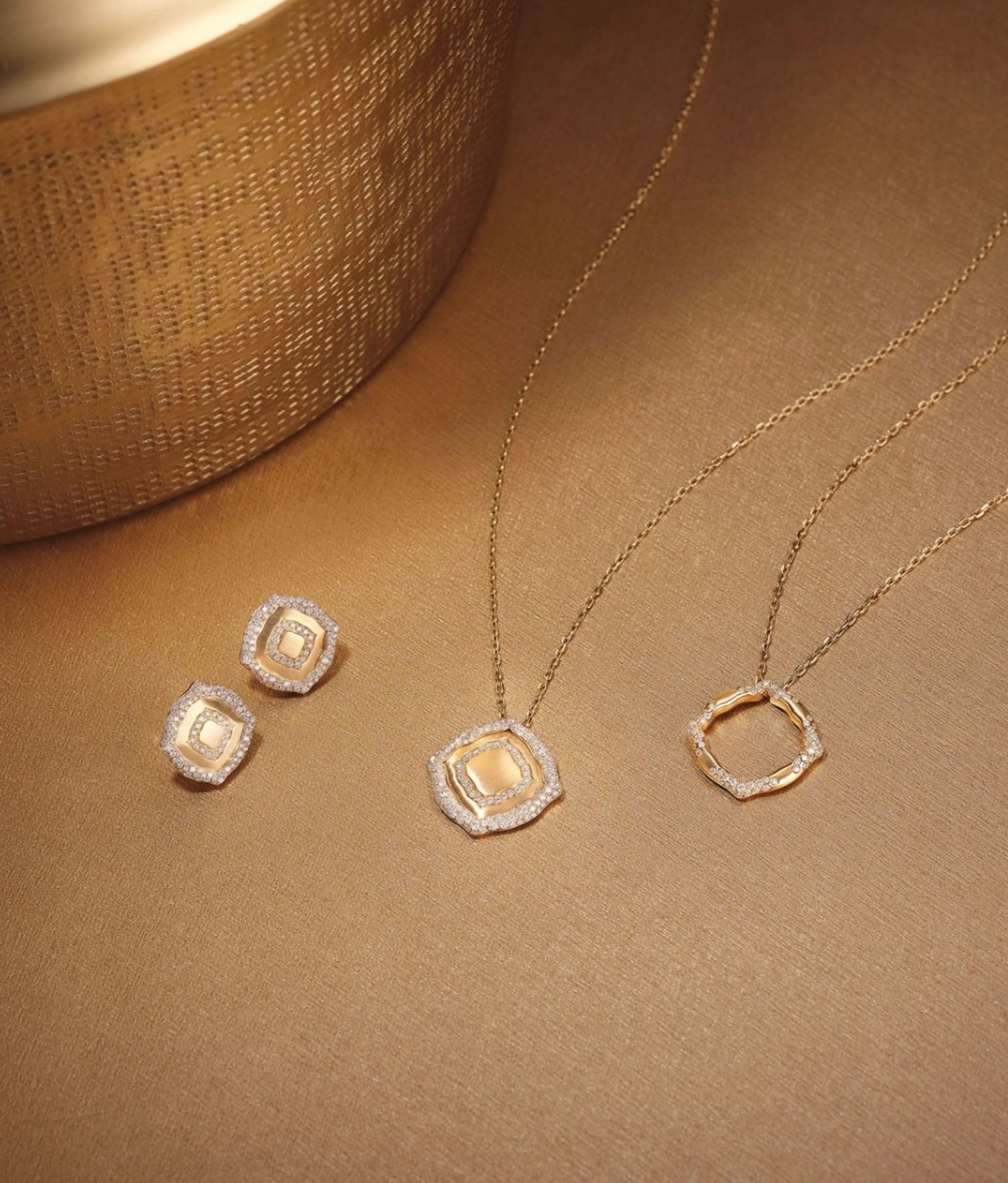
Pieces from The Nile Collection, inspired by Ancient Egypt.
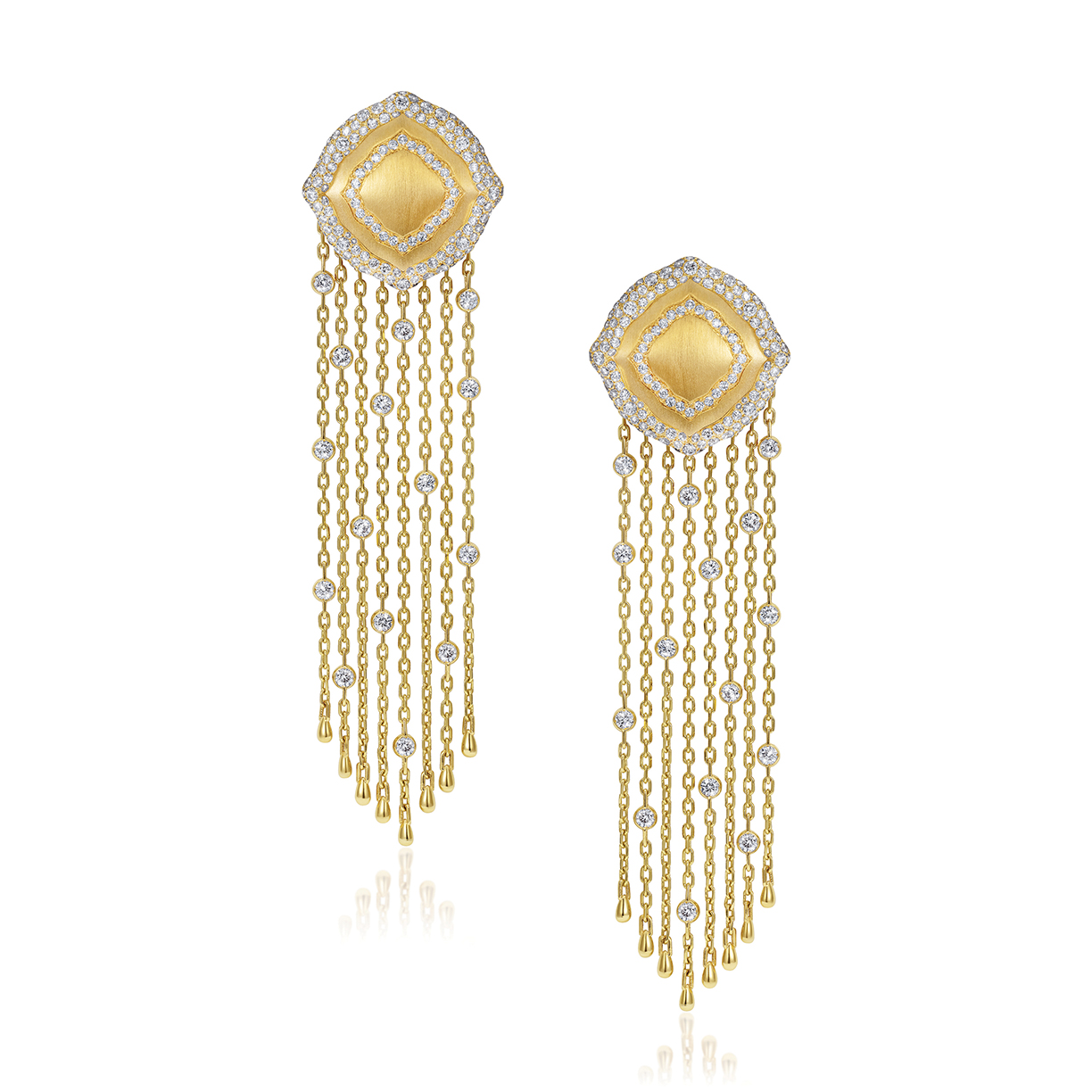
The Nile Yellow Gold and Diamonds Fringe Earrings.
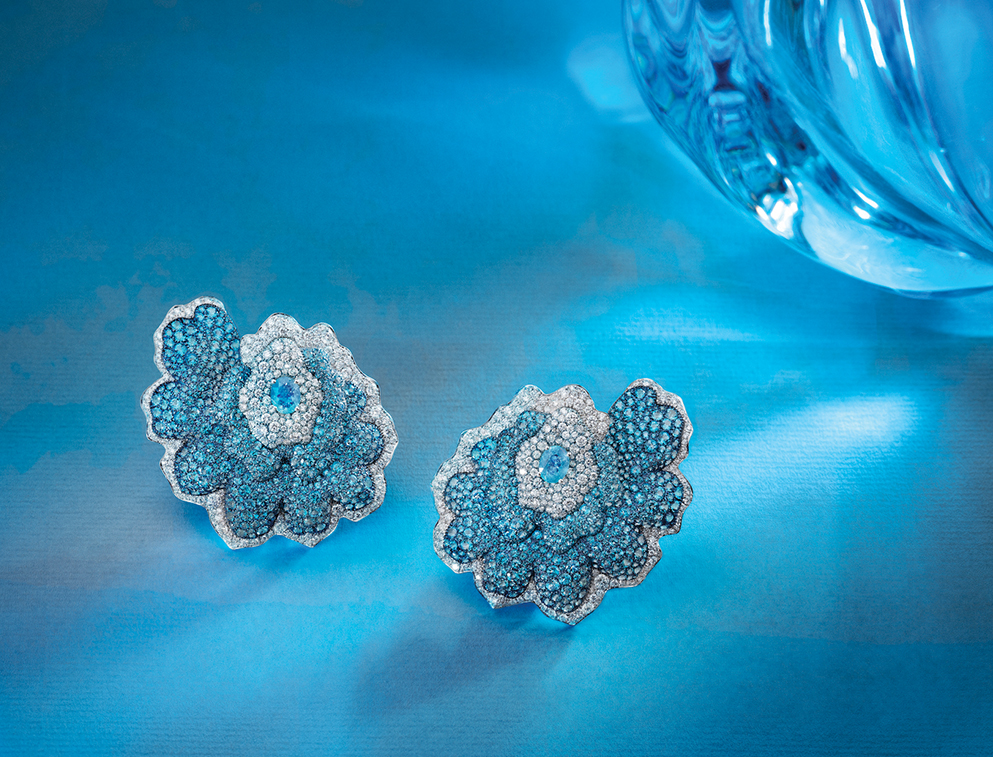
Enchanted Garden Titanium Paraiba Flower Earrings.
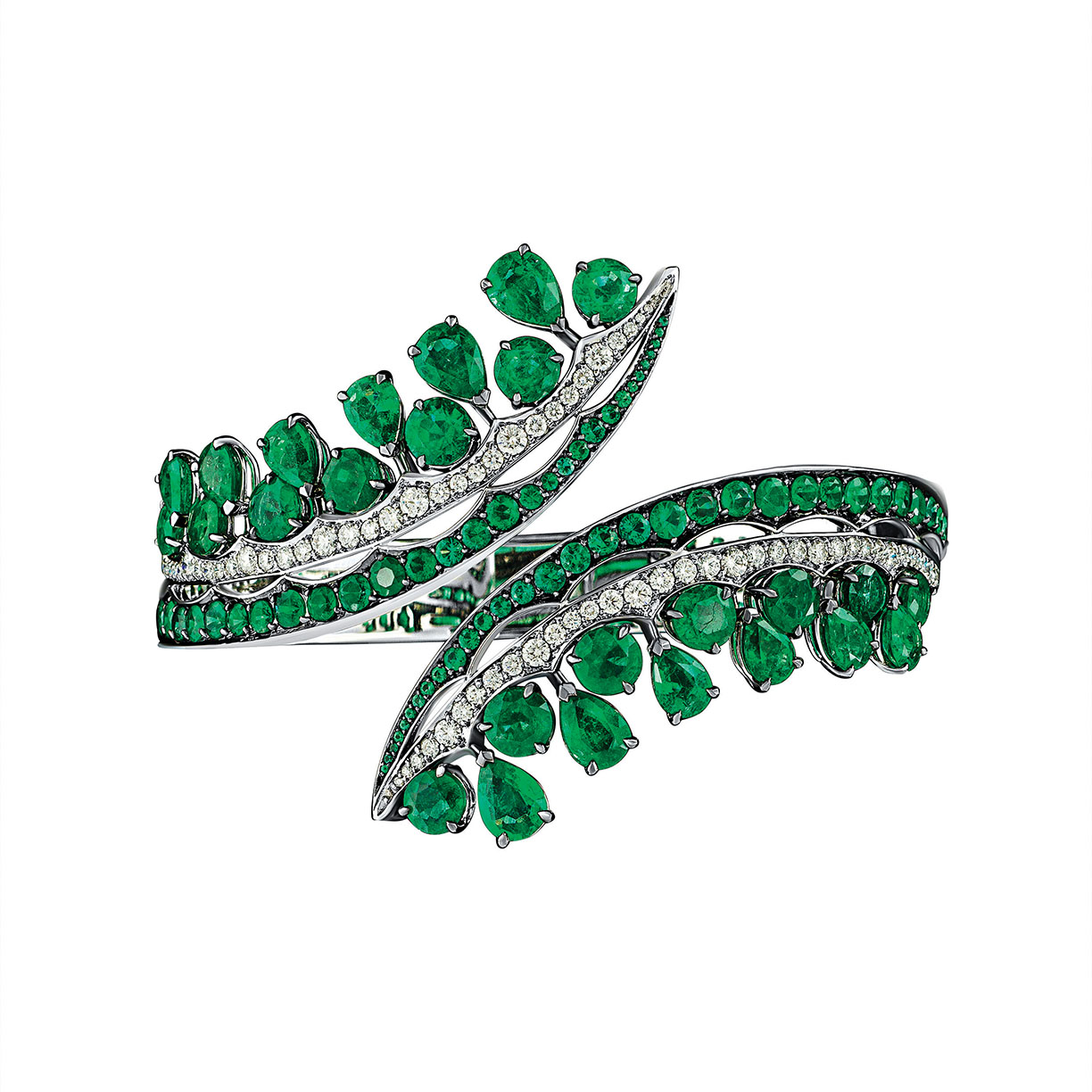
Legends of Africa Grand Bangle.
According to Vanleles Diamonds’ website, its “unparalleled belief in responsible mining” and commitment to the ethical sourcing of gemstones and precious metals has brought a new direction to the world of fine jewelry, one that is based in purposeful luxury and beauty.
“For my collections, and depending on which gems I need, I will mainly source them in Africa; Zambian for emeralds, Mozambique for rubies, tourmalines of all colors, Namibia for diamonds and Madagascar for pink and other multi-color sapphires,” Leles explained. “Most recently, Nigeria for blue sapphires. When I can, I travel to these locations personally to buy my gems, other times we work with suppliers that adhere to human rights policies and have strong corporate social responsibility.”
Vanleles Diamonds’ strong commitment to responsible mining and the African community is evident in its philanthropies, mainly the Malaika Foundation, a charity that seeks to empower Congolese girls and their communities through education and health programs.
“The funds we give go straight into these communities that so desperately need them, and in a very fast manner,” Leles says. “For Malaika, for instance, they only have one employee outside Congo, and no real estate rent, so the money is really going into the community and not to pay high salaries and rents in the West. We sponsor girls, and I can see tangible results directly. We chose charities that are small and the employees are on the ground.”
For an especially unique piece, Vanleles Diamonds offers bespoke consultations for custom made, handcrafted jewels. “The design process always starts with the client’s wishes.” Leles says. “During our meeting, I am able to capture their true desire, understand their lifestyle and then we embark on a unique journey to create something exceptional that will last generations to come.”
Finding friendship in diamonds allows Leles to focus on the most important things in her life — her family and business. “[I have] freedom of creations, where to source, how to send my message and freedom for being a mother of young children, I can work when I put them to bed and not miss many matches and activities,” Leles says. “But I certainly work longer and harder!”
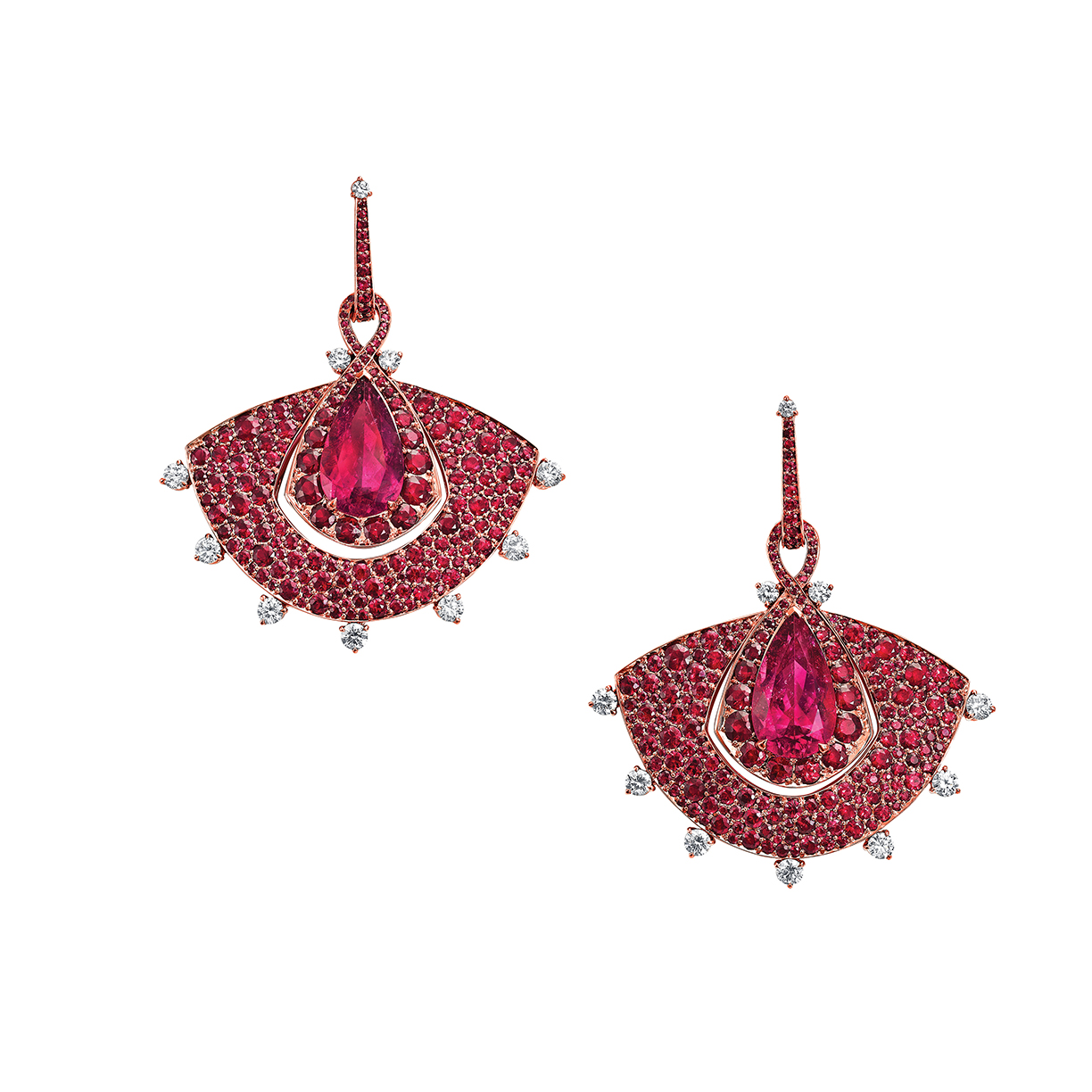
Above: Out of Africa Fan Earrings crafted in 18k Rose Gold with Mozambican responsibly sourced rubies and rubelites.
Below: Statement Cocktail Ring
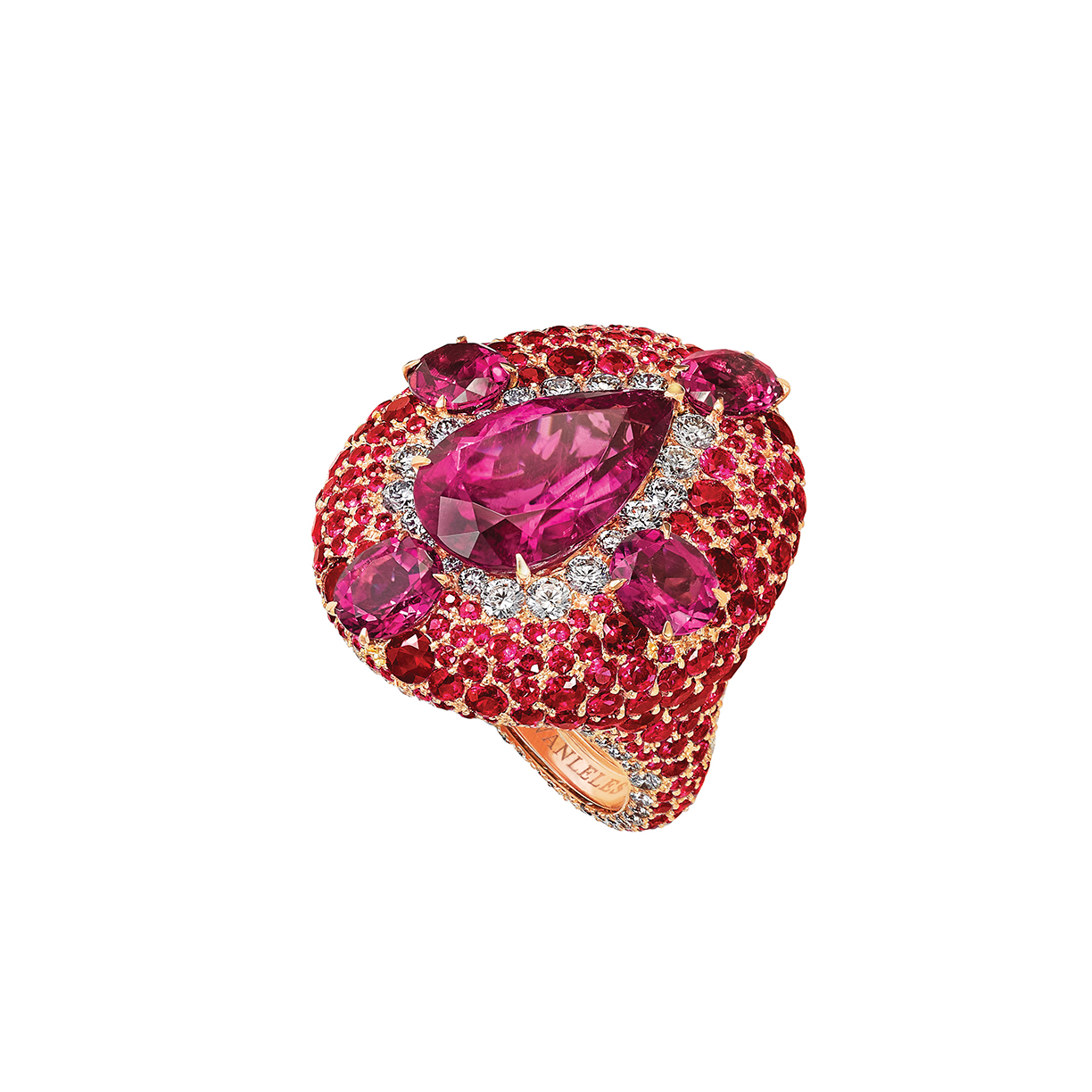
For Anna Bario and Page Neal, designing jewelry meant more than choosing the perfect stone — it meant making a lasting impact. Their company, Bario Neal, was born from the idea that “our most precious things come with a story,” and the beginning of that story is of utmost importance.
Sustainable fashion has eased its way into the growing culture of being environmentally mindful, and with this movement came an increase in jewelry companies focusing on how to source gemstones and metals without causing a devastating impact on the environment. For Bario and Neal, the principal and lead designers of their company, they sought to create jewelry with a meaning, saying, “to us, creating objects of lasting value means understanding their full impact and origins. [That means] the places the raw materials come from, all the hands that touch the materials and the jewelry as it’s made.”
The Philadelphia-based company creates all their jewelry pieces by hand, with all their diamonds and colored gems being traceable, mine to market products. The design process starts with the aesthetics of the piece, then to how it will be crafted and its functionality, says Bario and Neal. “Then we work out how to make it responsibly. That can mean researching new sources, new materials, or custom cutting.”
Along with supporting sustainable jewelry, the company, which mainly creates engagement and wedding bands, also supports LGBTQIA rights, working to “undermine and eliminate the presumption of heterosexuality that pervades much of the wedding and jewelry industry,” says Bario and Neal. “Supporting unity and advocating for human rights within the jewelry industry is a non-negotiable part of our mission.”
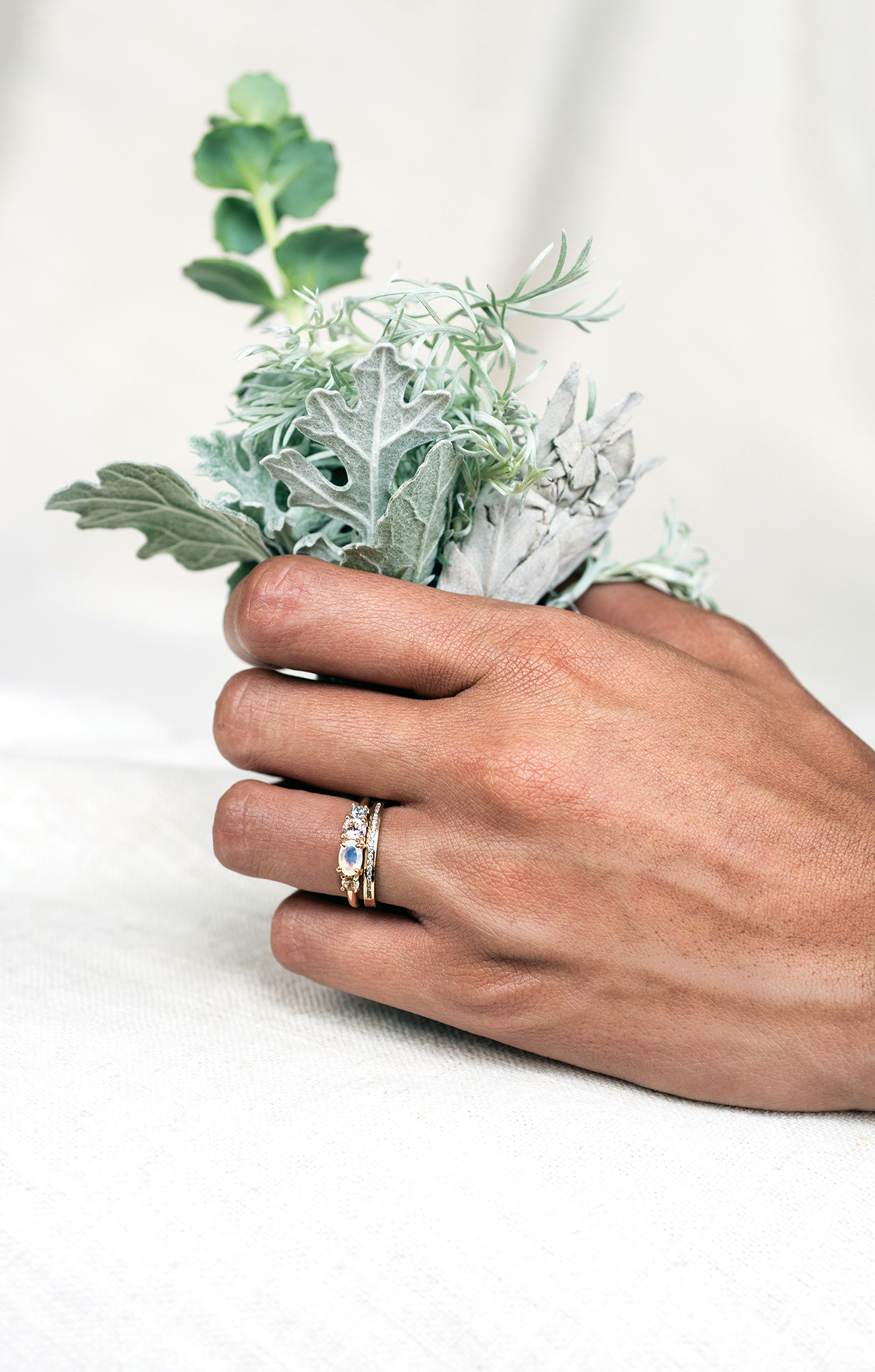
©Bario Neal Jewelry
Bario Neal

Photo by Daniel Johnson
Caitlin Cimino
Like Bario Neal, for Caitlin Cimino and her namesake jewelry company, the story of her ethically sourced pieces is essential to her craft. Cimino, who started her company in 2010, takes a hands-on approach when it comes to her creations. “When I create jewelry, I tie a mindful practice around the entire process — from collecting plant material to sifting through mine debris for gemstones.” Cimino started her ethical business knowing the connection between the jewelry industry and the gemstone and metal mining industries, two industries that are “environmentally and ethically damaging,” Cimino says.
All the gemstones Cimino finds are collected from a privately owned mine in California where her company is based. According to her website, unlike other mines that neglect their surrounding environment, the mine Cimino visits encourages local ranchers to utilize their mining debris in their orchards. The metal she uses is high-quality, up-cycled sterling silver with its impurities removed, making the quality similar to newly mined metal. Cimino describes her jewelry as “Medicine Jewelry™” and has created a process surrounding this ideal. “When I sit at my workbench, I perform different ritual practices like lighting herbs and incense, saying prayers or mantras and setting intentions,” Cimino says. “I do this because everything we involve ourselves in has a story and energy intertwined within, and I believe in the importance of making the story of my jewelry pure and positive.”
For co-founder of the jewelry company Puck Wanderlust, Ranelle Chapman, a core mantra pulls together the focus of her brand with it being “one of collaboration and the shared wealth of skills to create something unique yet mindfully made,” says the company’s website. “The interest in sustainability is at the heart of the brand — from packaging to production.” Founded in 2015 in London, the name is derived from “Puck,” a mischievous fairy in English folklore, and “Wanderlust,” a strong desire for travel and adventure. The company’s team traveled outside of its home country to India and Bali where its jewelry is handcrafted.

Sun Mandala bracelet in silver
by Puck Wanderlust.

A mix of different gold rings with onyx and moonstone by Puck Wanderlust.

Photos courtesy of Puck Wanderlust
Moon Mandala pendant necklace in gold
by Puck Wanderlust.
Puck Wanderlust works with small family-owned suppliers in these countries, their suppliers using recycled materials where possible while providing fair wages for their staff. According to the company, “we are committed to the ethical sourcing of our semi-precious stones and work closely with suppliers to ensure that they adhere to our code of conduct, which outlines strict standards of business behaviour.”
Puck Wanderlust also draws design inspiration from the countries that provide them with their materials. The latest “Bombay Deco Collection” is inspired by Indian Art Deco with geometric motifs and vibrant colors and patterns, according to Puck Wanderlust. In this collection, every design is handcrafted using 100-percent recycled silver and 18-carat gold vermeil, with each stone being “lovingly set.”
Niki Grandics, founder and designer of Enji Studio Jewelry in California, also sources her materials from around the world, buying them as close to the source as possible, she says, with rutile coming from a Pyramid mine in Bahia Brazil and her rich red rubies from Liberia. Grandics, who has always loved fashion and design, chose to ethically source her materials after the Rana Plaza factory collapse in 2013. The devastating event killed over 1,100 garment workers and injured over 2,000 more people, shaking the fashion industry to the core and causing companies to change where they source their materials. “The factory produced clothing for large brands I shopped with at the time,” Grandics says, “and it was shocking to me that so many young women — most garment workers are women age 18 to 35 — died so that young women like me in the West could buy the latest trends.”

Puck Wanderlust
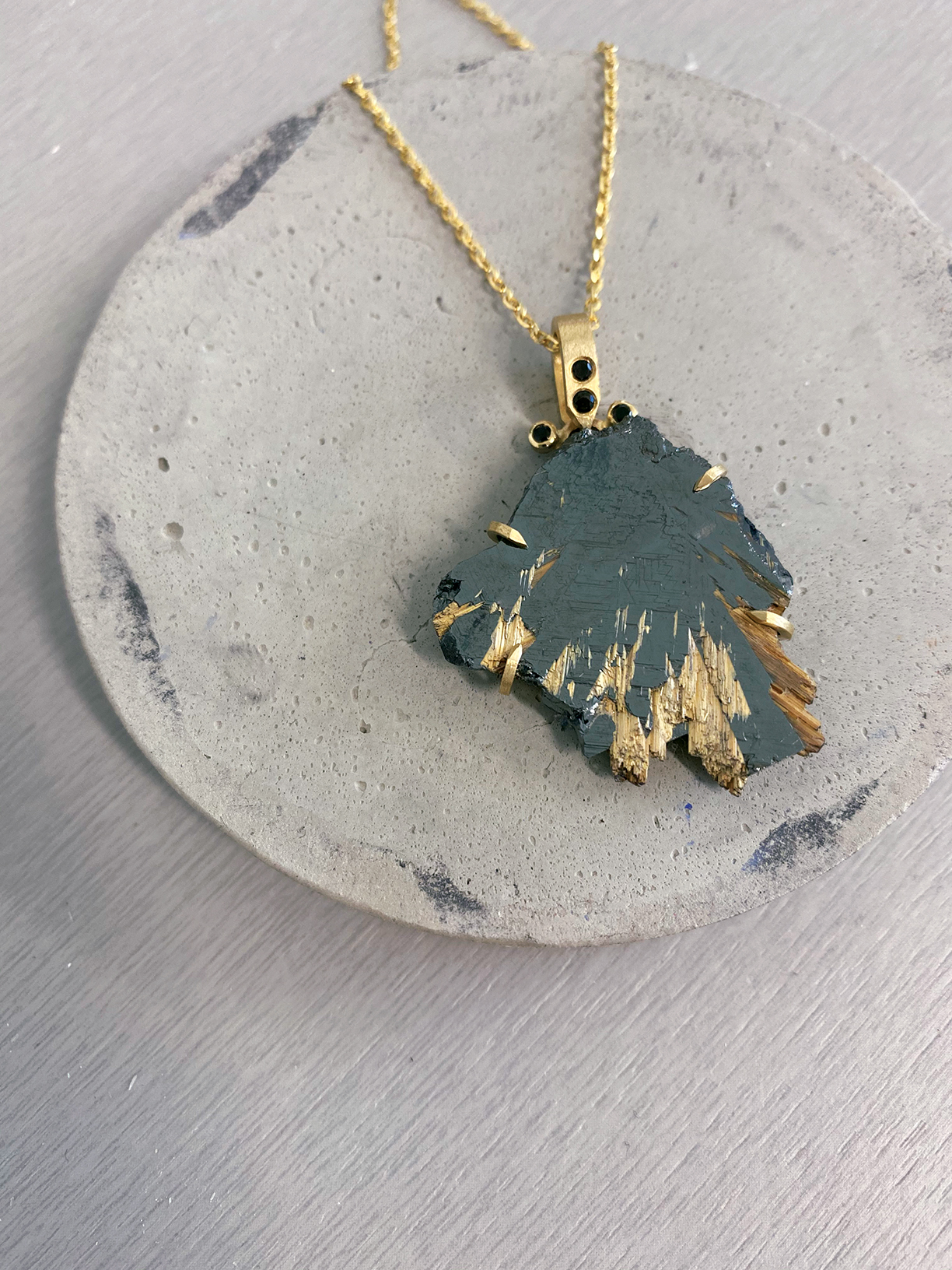
Photo courtesy of Enji Studio Jewelry
Grandics’s favorite recent creation, the Ankoma Pendant. It’s made of rutilated hematite stone and hand-fabricated with recycled gold.
Enji — its name derived from Grandics initials “N” and “G” — goes beyond making modern and minimalist styles, but looks to shed light on issues in the industry that people may not be aware of, supporting projects that help end the use of toxic chemicals such as mercury, which is harmful to people and the surrounding environment.
Grandics’ future plans include putting together a map of where all the gemstones come from, creating “radical transparency,” something she believes fashion companies should start doing, along with becoming completely sustainable. “We only have this planet as far as I know and, given the scale of climate change, I think it’s imperative,” Grandics says. “If it can’t be reused, recycled, or biodegraded, it shouldn’t be in production, period.”
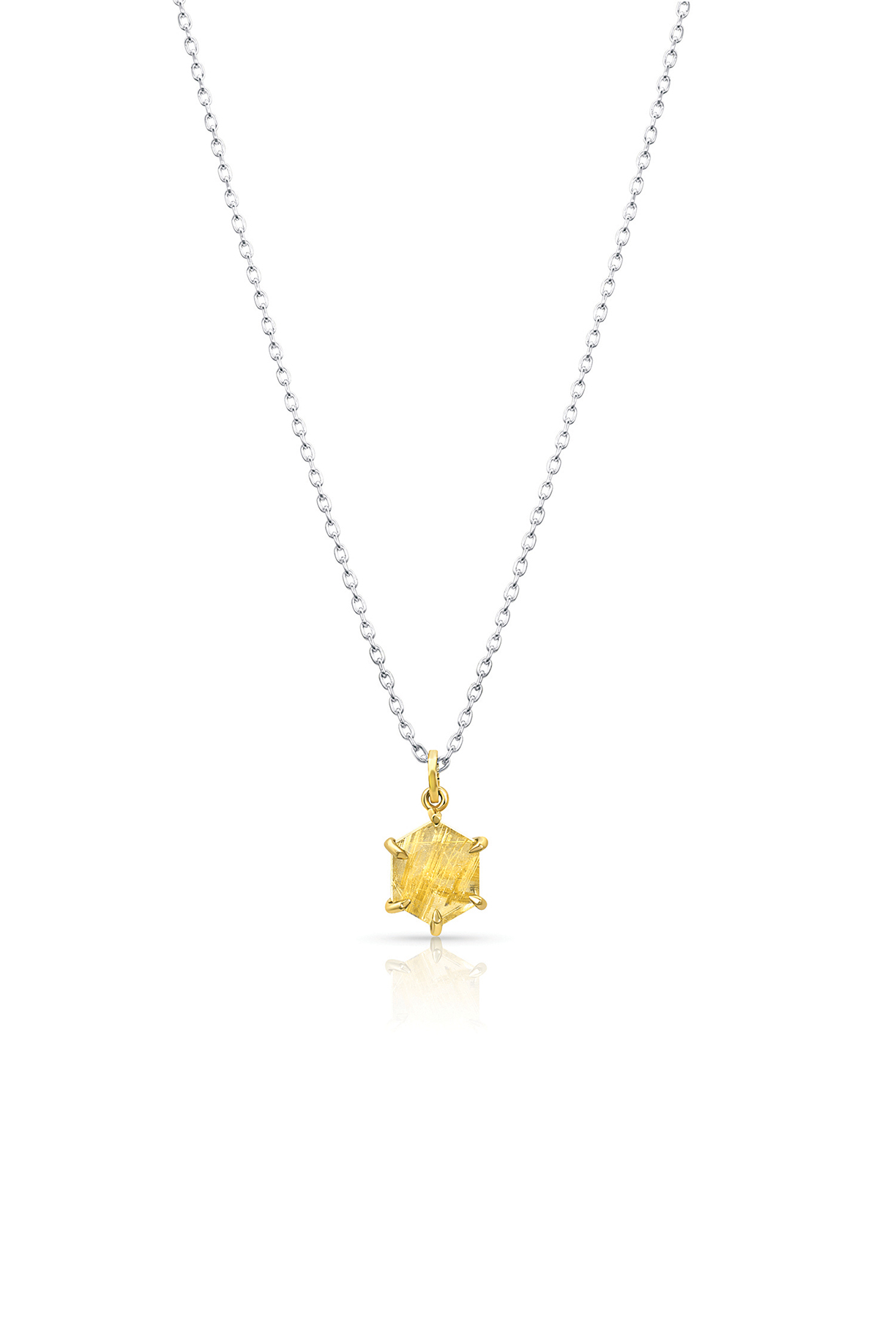
Photo courtesy of Enji Studio Jewelry
Aline Pendant: 2.25ct rutilated quartz and recycled 14k gold.
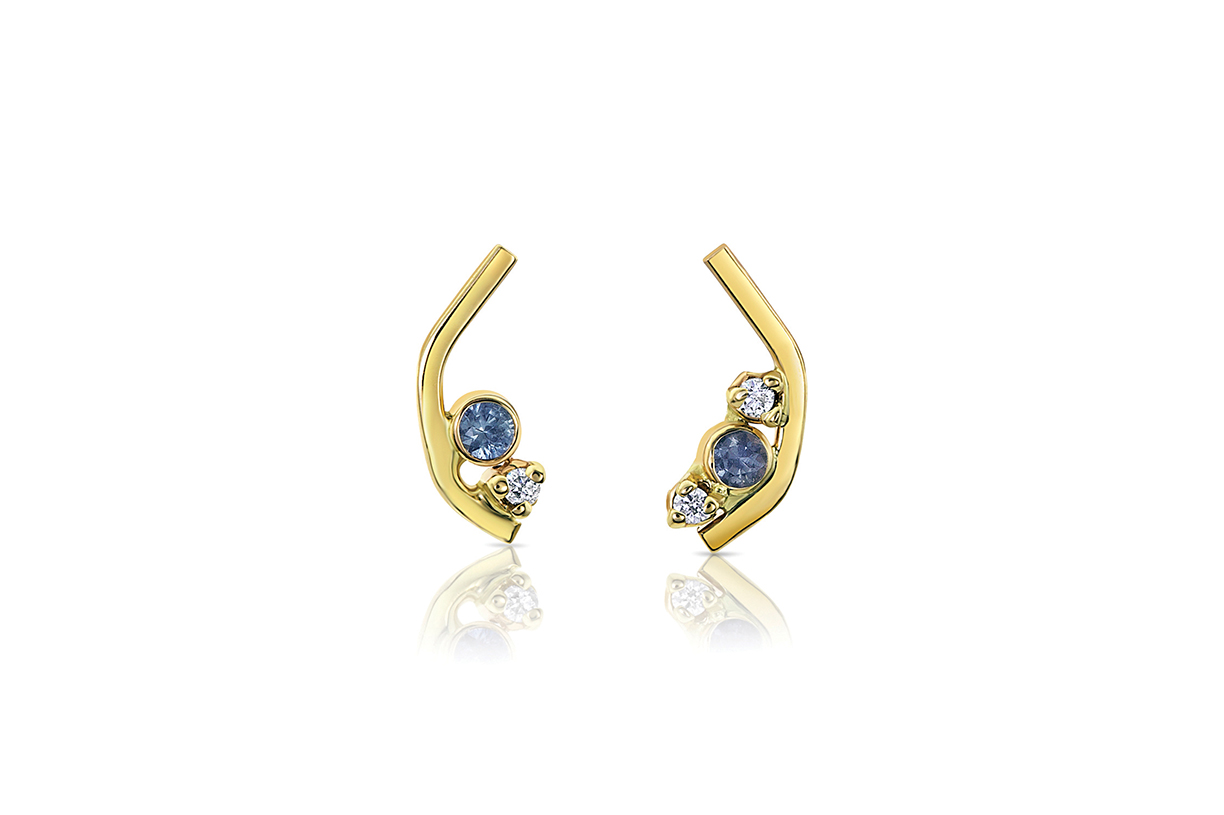
Paavo Studs: Recycled 14k gold, Montana sapphires and Canadamark diamonds.
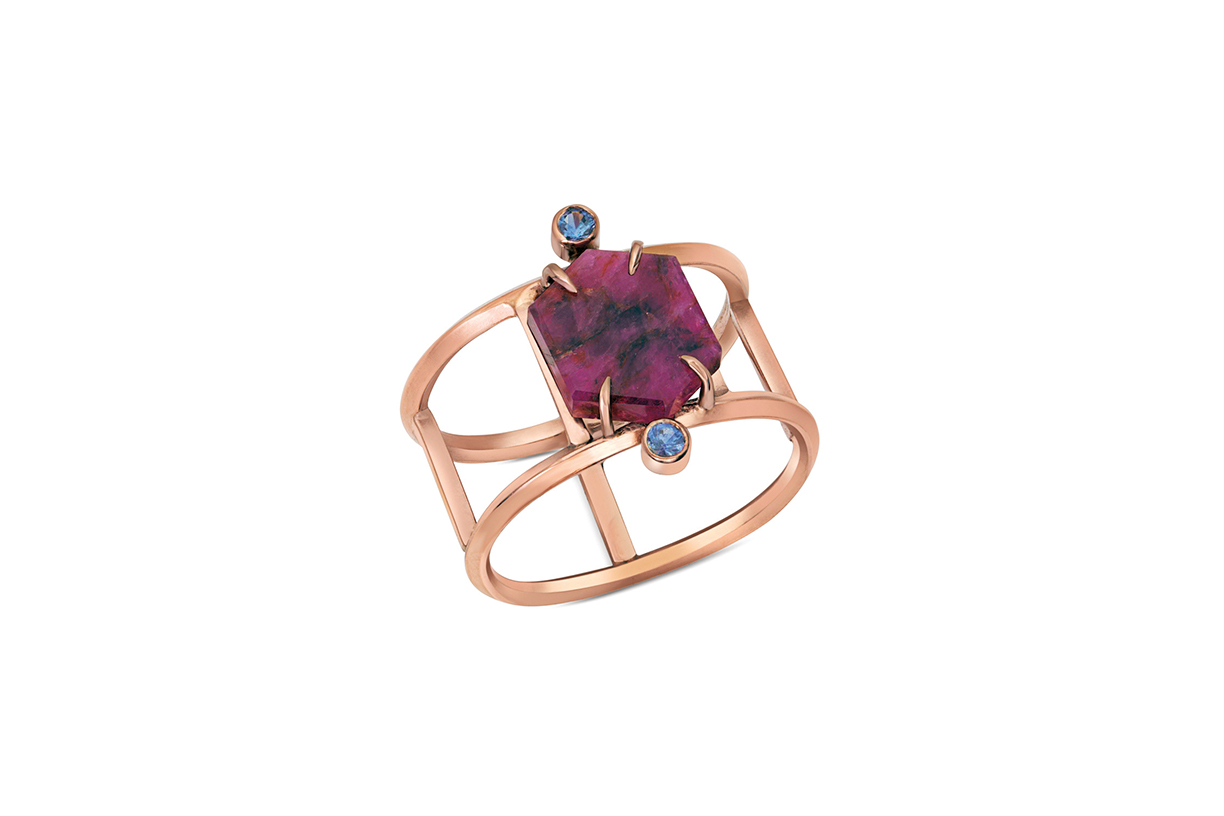
Photos courtesy of Enji Studio Jewelry
Faustina Ring: Ruby slice, Montana sapphires and recycled 14k rose gold.
Upon learning that her engagement ring possibly contained a conflict diamond, CEO and founder of MiaDonna Anna-Mieke Anderson knew she had to make things right for herself and the jewelry industry. “I started sponsoring Ponpon, a 7-year-old boy in Liberia, Africa,” Anderson says. “It’s through our letters that I got a first-hand look at the realities of living in a diamond mining community. I will never forget the day he wrote to me and said, ‘I had a great summer because only one of my classmates was killed.’”
Anderson set out to source conflict-free diamonds the best possible way she could find: growing them in a lab. MiaDonna has led the evolution in the lab-grown diamond industry, with the company debuting the largest USA-grown diamond at the time, at 6.28 carats in 2016. To help combat the issue, Anderson created a foundation, The Greener Diamond, that works together with MiaDonna, and empowers communities to grow food instead of mining diamonds. With each purchase of a piece from MiaDonna, the money goes toward programs that restore the lives and lands of people in sub-Saharan Africa affected by mining.
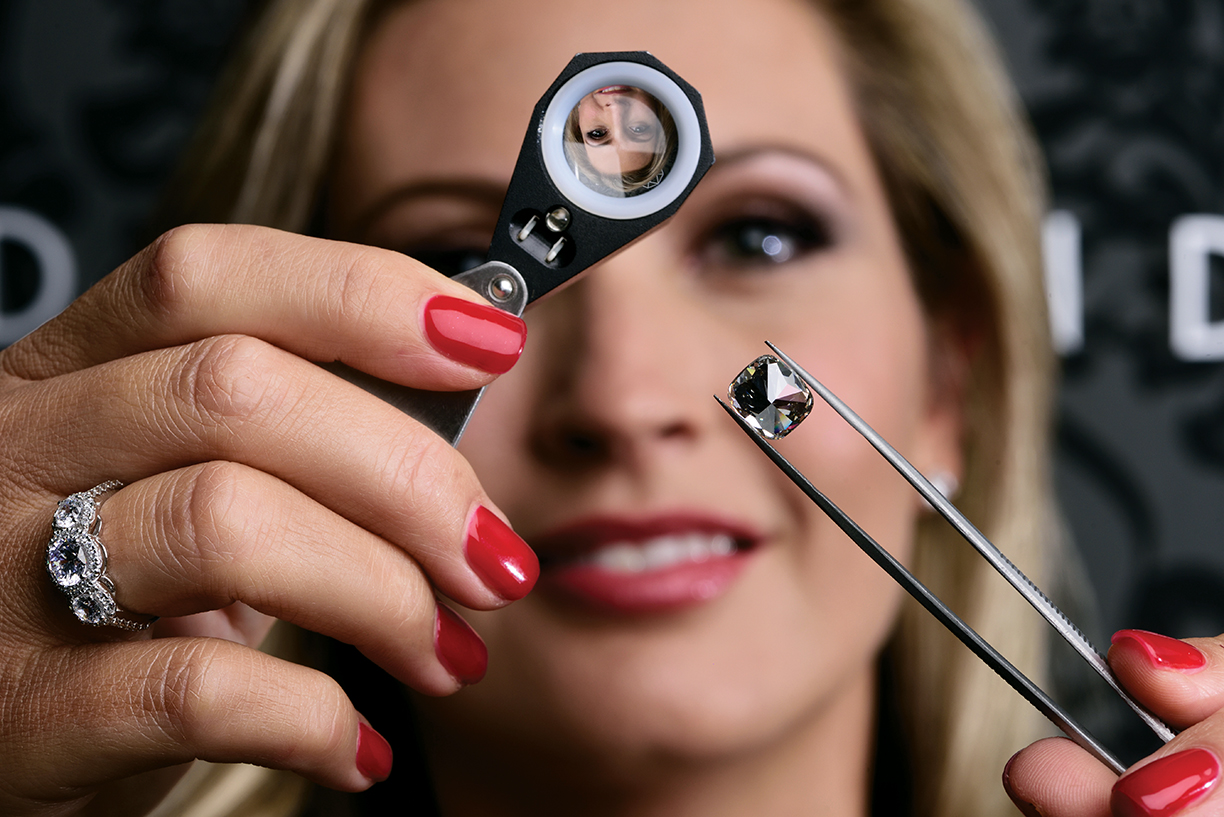
©2016 Alex Milan Tracy
Anderson’s company, MiaDonna, is named after the two most influential people in her life: her daughter, Mia, and her late mother, Donna.
According to Anderson, people should become more aware of where their jewelry is coming from because “every time we make a purchase, we are voting with our money.” Anderson is proud of where her company is headed, recently becoming B Corp certified in America, the first lab-grown diamond retailer to do so. But she isn’t going to stop there, looking toward the planet, her cause, and more importantly, the people, as her reason for making a difference. “As for the little boy, Ponpon, he just completed University and runs our foundation projects in Liberia, Africa.”
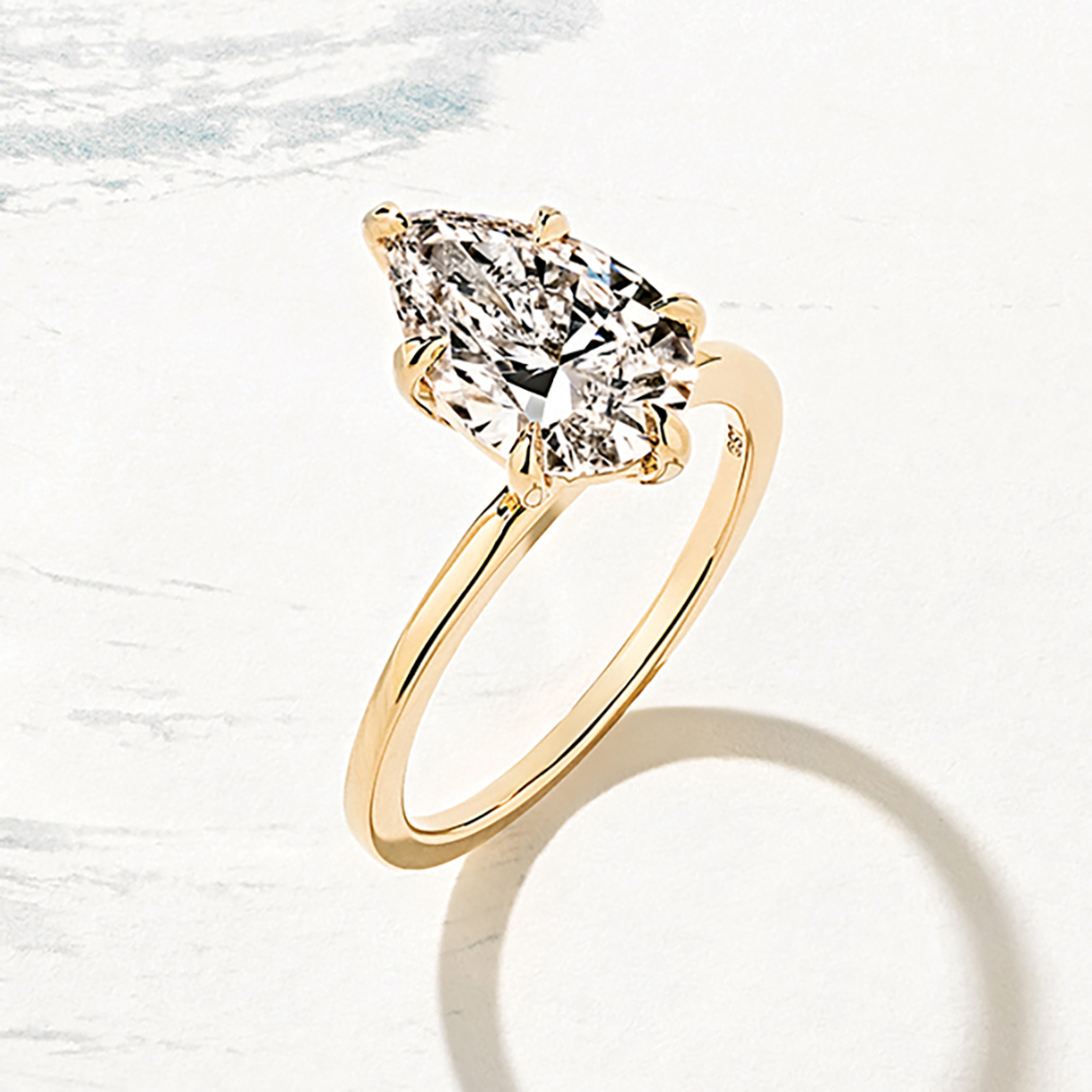
Custom lab-grown diamond ring by MiaDonna.
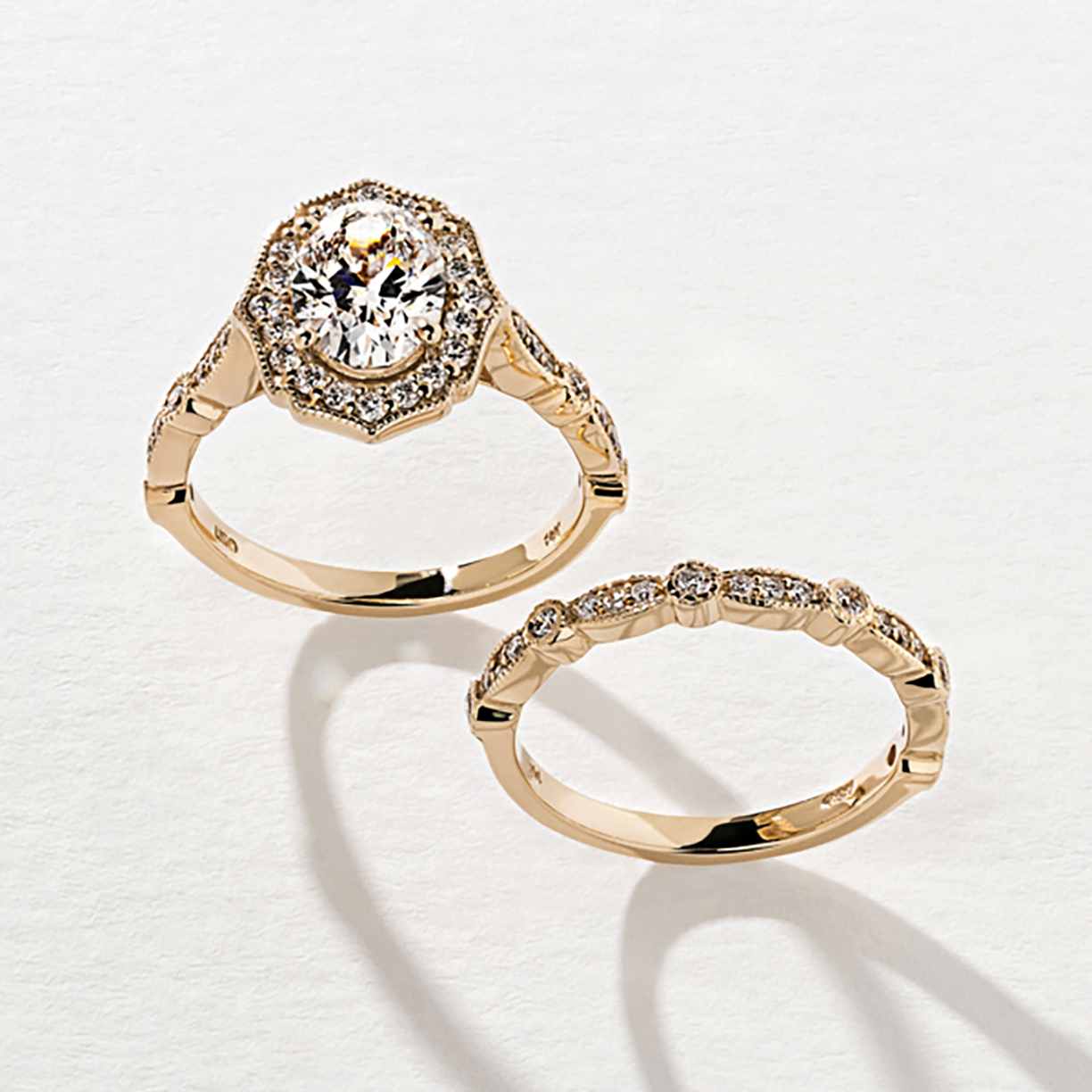
Photos courtesy of MiaDonna
Paris ring set with natural recycled diamonds by MiaDonna.
The word jewelry brings to mind beautiful, valuable accessories that elevate the wearer to a status reserved for those fortunate enough to afford these precious embellishments. As jewelry owners begin to amass a collection of fine adornments, there becomes a need for a place to keep their valuables organized and protected from potential damage.
There are several luxurious options for a refined gem collector. These opulent jewelry boxes, which retail for more than $3,000, prove that high-end jewelry is deserving of a home that matches its elegance.
Jewelry Box In Royal Ebony Macassar
$4,623.15
Only a limited quantity of these boxes have been manufactured with rare wood that features a never-before-seen grain pattern. This product is designed to serve as two jewelry boxes in one, as its lower tier is easily removable for travel purposes. Two keys adorned with tassels unlock a top tray with an internal mirror, making this jewelry box an elegant gift that doubles as a means of both storing and displaying the owner’s jewelry collection.


Russian Karelian Birch Jewelry Box
$3,434.34
Handmade from a Russian royal wood that was previously used exclusively to make furniture for Russian tzars, this jewelry box’s modern aesthetic is enhanced by the rich nature of Karelian Birch. It also features a two-in-one design with a removable tier, and is lined with cream suede complimented by nickel-plated hinges.
Japanese Tamo Ash Exclusive Creations Jewelry Box
$4,623.15
Japanese Tamo Ash wood is one of the most rare and luxurious woods in the world — known for its unique and eye-catching grain pattern, the wood used to be used to decorate only the finest Samurai swords on the island of Hokkaido. Now, it is used in luxury items including the dashboard of Bentley cars, and this stylish, versatile jewelry box.

Photos courtesy of iWOODDESIGN.
Luxury beauty brand, La Prairie, showcases its latest product at The Crown, a penthouse located at Madison Equities’ 212 Fifth Avenue in New York City.
By Brielle Bryan
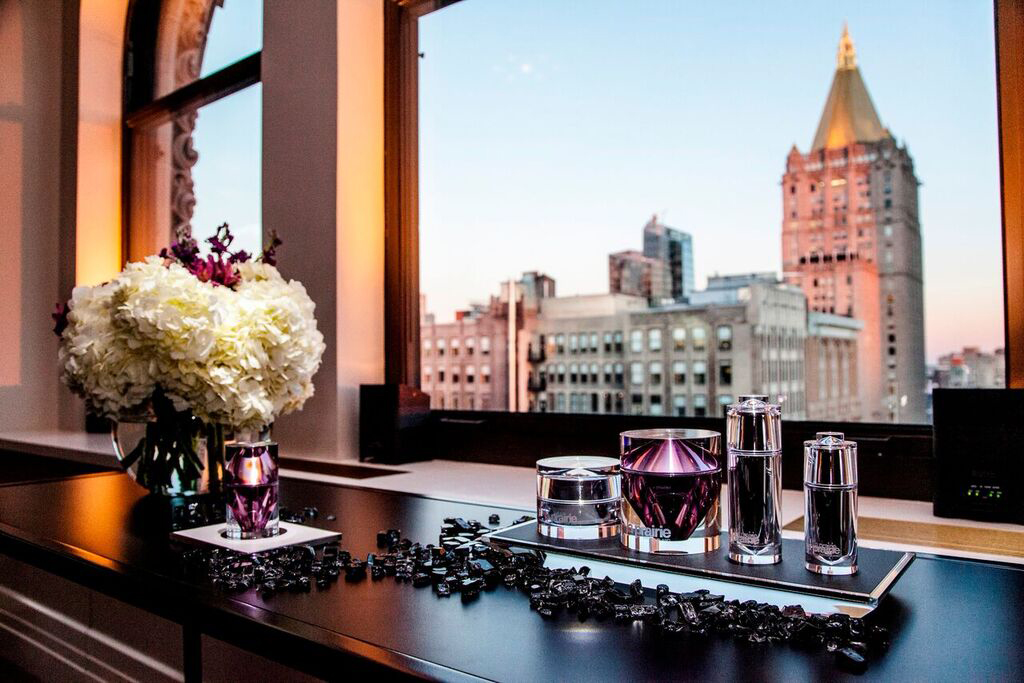
Majestic purple hues filled The Crown, the penthouse at Madison Equities’ 212 Fifth Avenue, as guests enjoyed intricate hors d’oeuvres and sipped on signature cocktails amidst the glistening New York City Skyline. Top beauty editors, influencers and real estate professionals gathered together to celebrate the launch of La Prairie‘s latest product, Platinum Rare Cellular Night Elixir.
La Prairie, a luxury beauty brand based in Switzerland, is most widely recognized for its anti-aging skincare products which have a cellular complex. La Prairie’s quest for timeless beauty began when the brand was founded in 1978. Its products give new life and energy back to the very cells where beauty is born, enhancing the skin’s natural renewal process.
The sweeping 10,079 square-foot triplex was transformed for the luxury brand’s unveiling of its new elixir. The Crown became an intimate wonderland, filled with posh cosmetics and opulent jewels, including a showcase of exquisite jewelry provided by Van Cleef & Arpels.
Guests were given the opportunity to view the new elixir, and were also offered eye treatments and hand massages in the dimmed rooms on the penthouse’s first floor. The candlelit second floor of The Crown led guests to the top floor of the penthouse, where guests were treated to sweets and custom cocktails, as well as one-of-a-kind views of New York City from The Crown’s private outdoor space.
Photo courtesy of Natalie Poette
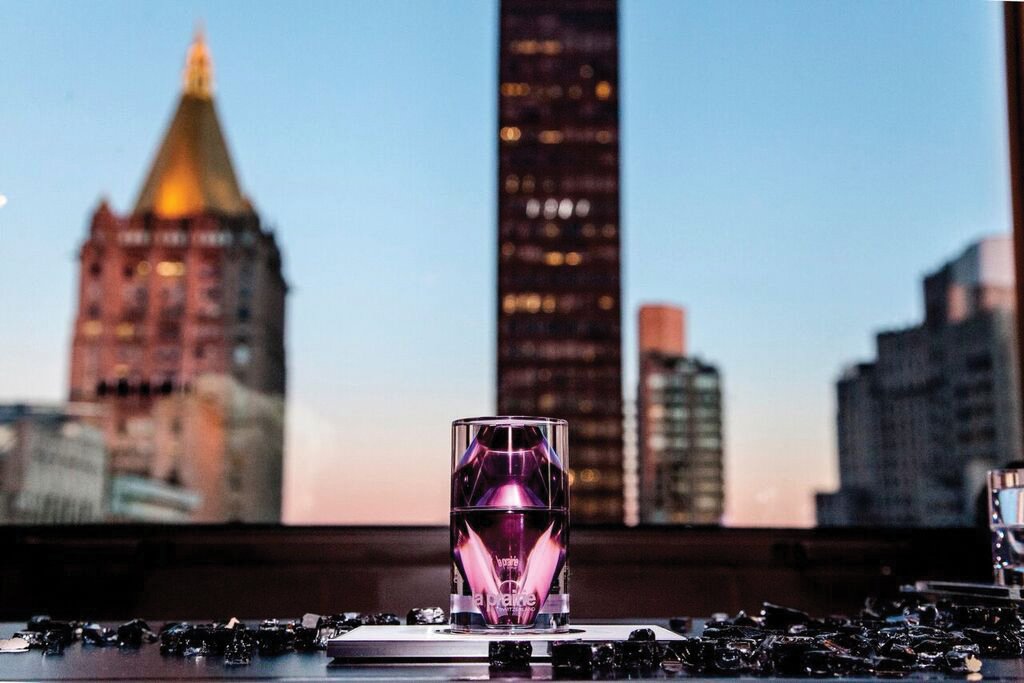
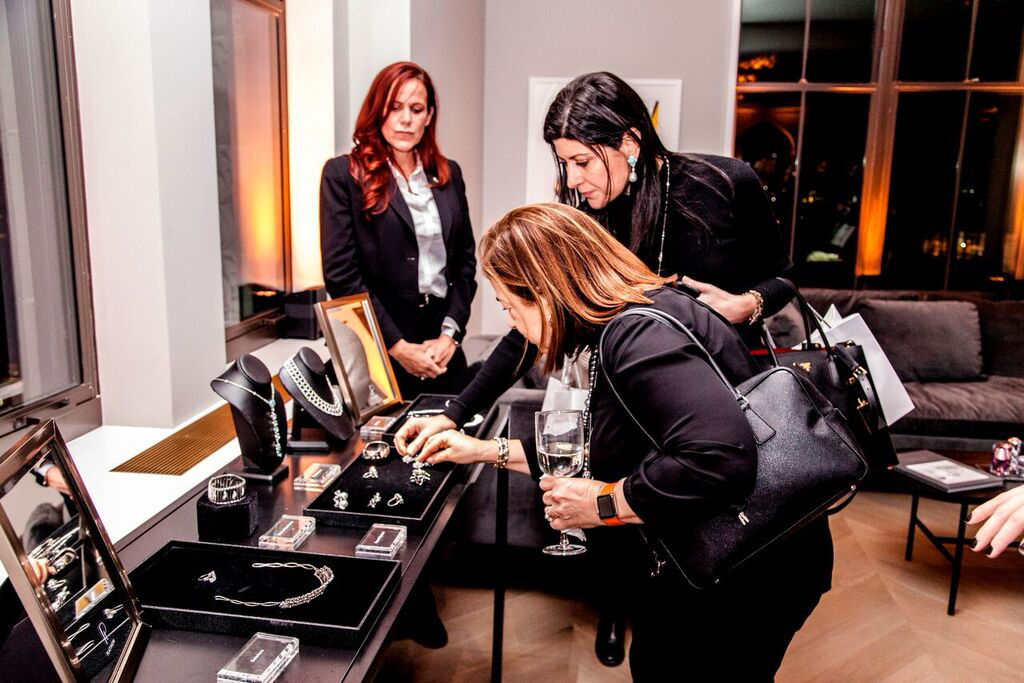
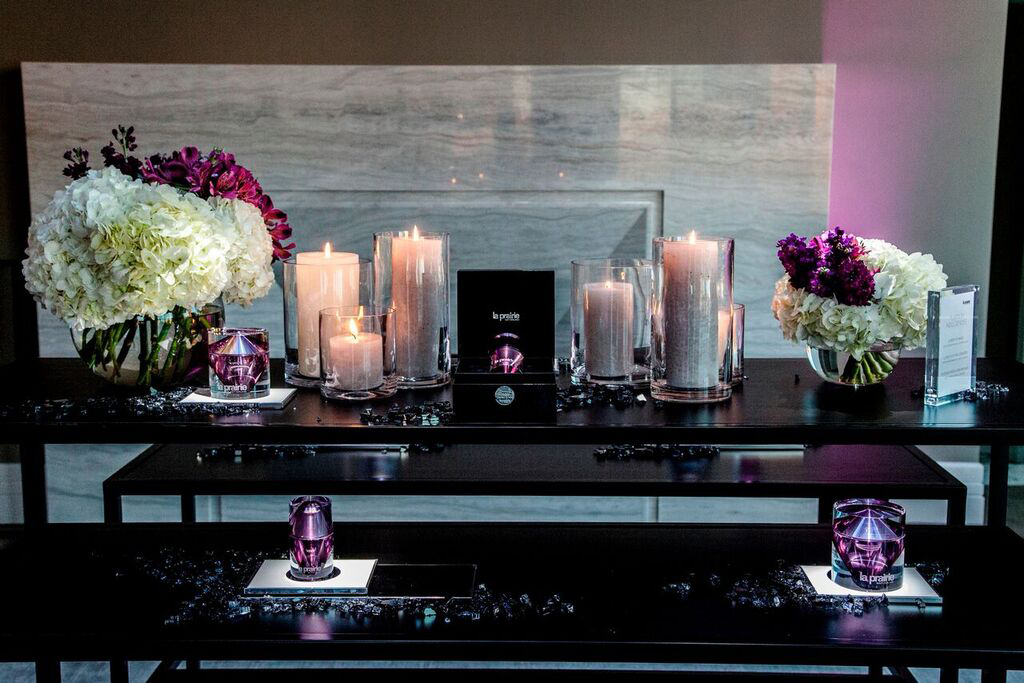


At a November auction, de GRISOGONO’s ‘The Art of de GRISOGONO, Creation 1‘, broke records at the landmark Magnificent Jewels sale in Geneva. The ground-breaking necklace sold for $33,701,000.
This breathtaking masterpiece was designed by Fawaz Gruosi, the founder and creative director of de GRISOGONO.
The sale, which was the largest ever emerald-cut diamond offered at auction, marks a new milestone for de GRISOGONO. It broke the previous record price for a D Flawless Diamond which was $30,600,000.
“This auction marks a high point for de GRISOGONO and the team that have worked so tirelessly to bring this incredible stone to life in this beautiful piece, Creation 1,” Gruosi said. “This is the largest emerald-cut diamond ever to come to auction and so it was uncharted territory. I am truly privileged to have had the opportunity to work with a historic stone of such perfection and would thank everyone who has taken part in this beautiful journey from mine to masterpiece.”
The 404-carat rough diamond was acquired from the Lulo mine by de GRISOGONO’s partner, Nemesis. The final design was chosen in February 2017, in keeping with de GRISOGONO’s daring creativity, whilst simultaneously being fit for such a significant stone. Fourteen highly-skilled artisans spent 1,700 hours creating this astonishing necklace.
This diamond has impeccable credentials, entirely traceable from mine to masterpiece and compliant with the Kimberley Process certification authority. The 163.41 carats emerald-cut diamond has been certified by the GIA, the world’s foremost authority on diamonds, colored stones and pearls.
photo courtesy of de GRISOGONO
Contemporary designers around the world are transforming lighting fixtures from basic utility into artistic bling.
By Roger Grody
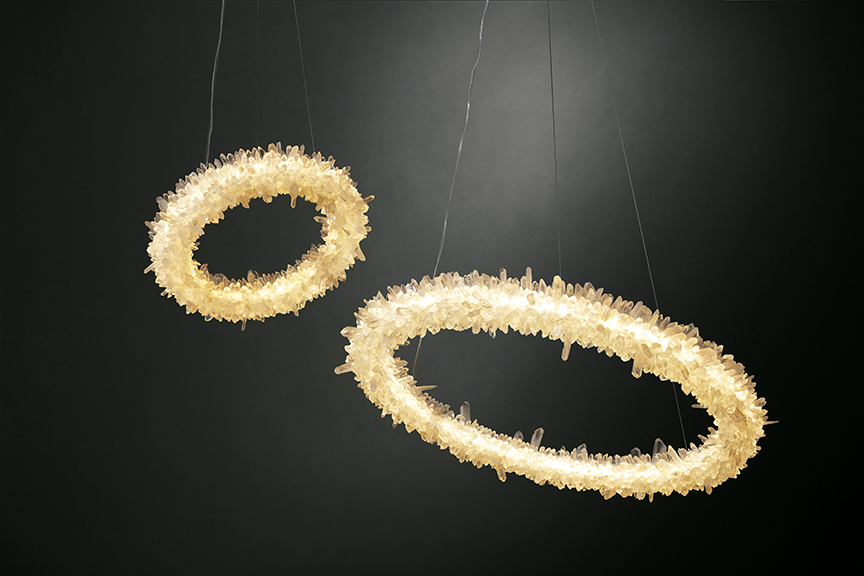
Diamond Ring by Christopher Boots. Photo by Christine Francis.
Talented interior designers compose seating, flooring and window treatments to complement each other like a wardrobe, requiring a delicate balance of fashion and functionality. Lighting was once viewed as mere utility, but the fixtures produced by today’s premier designers represent the jewelry that sets off an outfit.
Drew McGukin, a New York-based designer with a national clientele, reports that although dramatic lighting can sometimes short-circuit budgets, its value should never be underestimated. “I think of lighting as an extension of the art in a space — a real opportunity for functional sculpture that immediately lifts a room,” says McGukin, who welcomes the myriad of innovative products currently available. Among the lighting designers he favors are fellow New Yorkers Lindsey Adelman, an industry leader, and Stephen Antonson, whose work is distinguished by his creative use of plaster.

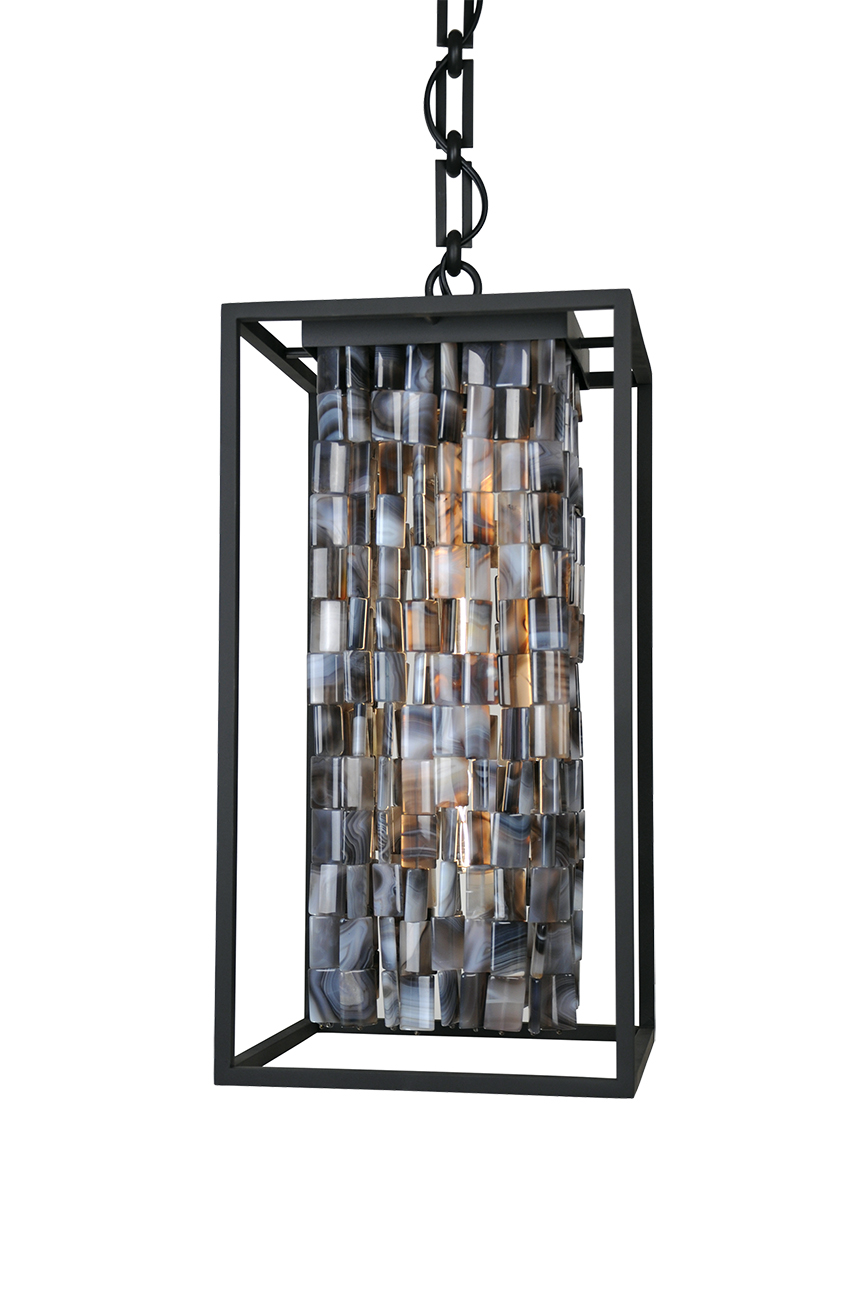
Top: Bubble Burst in oil-rubbed bronze with clear globs by Lindsey Adelman, photo by Lauran Coleman; Bottom: Alex Pendant Chandelier by Fuse.
“I’ve always surrounded myself with handmade things, art and antiques. They make good company because the maker seems to be present,” reports Antonson, who wants his chandeliers to evince this feeling and eschews polished, silky finishes. “No two are alike and you can actually see my hand in every one,” he explains. Indeed, Antonson’s plaster has a tactile, organic quality in which you can almost make out the artist’s fingerprints.
Adelman is the darling of world-class interior designers and architects, and her work—an extraordinary fusion of art, whimsy and electricity once reserved for Manhattan penthouse dwellers — has found a global clientele. She is as much a movement as a designer, and Adelman-inspired knockoffs are so ubiquitous that even suburban homeowners are unwitting fans of the designer.
At Lindsey Adelman Studio, the founder surrounds herself with a staff of metalworkers, architects and philosophers, all dedicated to pushing the limits of lighting design. Adelman says of her craft, “It’s structural and sculptural and you can test it immediately.” She also appreciates the unpredictable dynamics of anything that hangs from a ceiling, suggesting a chandelier’s relationship to gravity is far more seductive than that of static sofas or tables.
Adelman is inspired by the work of renowned architects Santiago Calatrava and Shigeru Ban. And although one can see the influence of those masters’ daring sculptural expressions in Adelman’s cantilevered fixtures, she humbly characterizes her personal style as simply “combining the practical and sensual.”
Her studio’s first product was a modest version of Adelman’s now-signature Burst, an explosion of hand-blown globes and spikes inspired by vintage French jewelry and Medieval flails. The Boom Boom Burst, a spectacularly oversized edition of that inaugural piece, is priced well north of $100,000.
“I think that, more than ever, designs are driven by self-expression,” states Adelman, who notes this is still a nascent trend for products designed for mass-production, but quite prevalent among independent designers who self-manufacture. “Lighting is the perfect medium for this kind of expression,” she insists.
Across the country is Los Angeles-based Fuse Lighting, where founder Kevin Kolanowski uses semiprecious stones to elevate lighting fixtures into an haute couture of electricity. “Designing lighting has really been an ongoing exploration for me,” says Kolanowski, who, like Adelman, is influenced by Calatrava, as well as architects Carlo Scarpa and Zaha Hadid.
“I appreciate all types of design, but have such a passion for lighting because of how it can completely transform the mood of a space,” says Kolanowski. His work is a testament to how a thoughtful selection of materials and forms profoundly influences how light radiates through a room. “Lighting is art, atmosphere, structure, and function all in one,” says the designer, who has always been fascinated by jewelry.
“I wanted to play with this idea of adornment using organic materials in my lighting design, but with a contemporary twist,” says Kolanowski. The designer began incorporating semiprecious gems into sleek geometric forms, calling his work “jewelry for the home.” Like a jeweler, Kolanowski manipulates natural materials into art, using citrine nuggets or amethyst chips to suffuse and refract light in different ways. Fuse’s Alex chandelier features a curtain of stone surrounded by a metal frame, and a particularly compelling combination of finishes is amber-hued carnelian nuggets juxtaposed against dark oil-rubbed bronze.
Kolanowski contends the industry’s embracement of miniaturized and flexible LED bulbs has encouraged the use of new materials and a wider variety of intricate shapes in lighting design. He states, “The forms that I’m working with now usually follow architecture and are more fluid than ever.”
Unlike some commentators, Jason Miller, founder and creative director of New York’s Roll & Hill, does not believe lighting has yet completely morphed into art. “Design is design. Art is art. The goals are different,” he insists, but concedes, “I do think it’s fair to say that lighting has become more expressive, which opens up a whole new world of opportunity for interiors.”
Miller has assembled a team of designers — including his celebrated crosstown peer Lindsey Adelman — that emphasizes the sculptural qualities of lighting, customized to clients’ specifications.
The Brutalist movement-inspired Gridlock pendant from Roll & Hill, created by Philippe Malouin, is a handcrafted, symmetrical assemblage of brass trusses, something that might have been created from a very sophisticated Erector Set. In addressing new trends, Miller states, “I think there is a group of young designers working right now whose work has more in common with Memphis or design from the ’80s than other periods.” He notes, however, “That work is usually rejected as being ‘ugly.’”
“I’m very inspired by nature,” explains Gulla Jónsdóttir, who adds, “There are no straight lines in the human body so why should we live in square spaces?” The Icelandic-born designer is a successful hospitality industry specialist whose chic Parisian restaurants and serene Mexican resorts reflect her organic, seductive imprint. She also authors collections of furniture, including some distinctive lighting pieces. Her Nest chandelier — the fixture’s outer shell is a collection of “twigs” crafted from salvaged rebar, while an inner shade surrounding the bulb is created from polished tubular steel — reflects the designer’s penchant for reimagining nature.
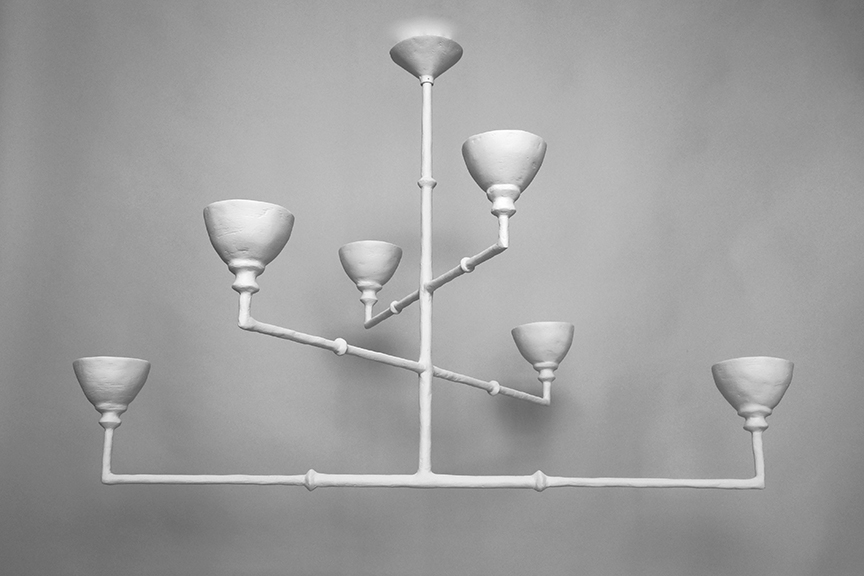
Alexander Chandelier by Stephen Antonson.
Among her peers, Jónsdóttir admires prestigious Italian furniture maker Henge — its polished silver-brass rings, seemingly floating in air, present an alluring minimalism — and Australian industrial designer Christopher Boots. The Sugar Stick pendants from Boots’ collection are delicate crystalline sculptures whose inherent energy is amplified through the flip of a switch.
Like Jónsdóttir, Boots looks to the natural world for inspiration. “From the formation of natural crystals and minerals over time to the molecular structure of organic matter, I’m always exploring the world outside the Anthropocene to drive my design practice,” he states. “I try and insulate myself from trends to allow my own visual language to develop without external pressures,” says Boots, who focuses on combining new technologies with traditional artisanal processes. He cites his quartz crystal-studded Diamond Ring and Prometheus chandeliers as reflecting his signature pairing of the unfinished or textured with highly polished edges.
From the perspective of an interior designer, McGukin offers, “There’s something beautiful about reaching to turn on a single lamp, or hitting a bank of switches and watching a room burst into a perfect glow.”
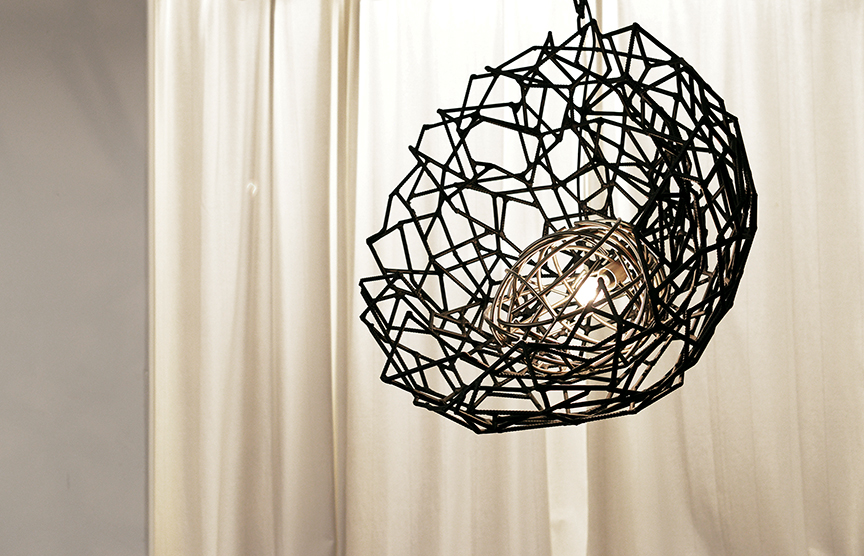
Nest Chandelier by Gulla Jónsdóttir. Photo by Jesus Banuelos.
Masters of Illumination
Christopher Boots: www.christopherboots.com
Drew McGukin Interiors: www.drewmcgukin.com
Fuse Lighting: www.fuselighting.com
Gulla Jónsdóttir Architecture & Design: gullajonsdottir.com
Henge: www.henge07.com
Lindsey Adelman Studio: www.lindseyadelman.com
Roll & Hill: www.rollandhill.com
Stephen Antonson: www.stephenantonson.com
These Italian artisans combine years of experience (some more than a century) and the finest materials to create some of the most luxurious handcrafted pieces of Italian jewelry. Their diverse backgrounds and sources of inspiration result in bold and unique designs that are sure to make a statement.
By Christine Aebischer
Regina by De Simone
The exquisite designs of the historic Neapolitan house, De Simone, are based on more than a century-long tradition. Francesco De Simone & figlio was founded in 1855, through a passion for coral and shells. And in 1990, De Simone Fratelli was founded to continue the family tradition of jewelry design. The unique coral pieces are the epitome of elegance and exude skills that have been perfected over years of dedicated craftsmanship. The Regina set comprises a gold necklace, bracelet, ring and earrings. The delicately feminine pieces are decorated with De Simone’s signature angel skin coral, diamonds and emeralds. Priced at $85,875.




Yin Yan Parure by Margherita Burgener
Designer Margherita Burgener’s jewels have been auctioned at Phillips de Pury in Geneva, Sotheby’s, Christie’s, Artcurial, Poly Hong Kong and Bonhams. Her unique creations are the result of her family’s century-long tradition as goldsmiths in Valenza, the hometown of high-class Italian jewelry. Burgener created her first original piece in 2003 and debuted her limited edition Boutique line in 2011. In addition to designing her own pieces, she oversees the craftsmen in her family’s workshop to ensure the rare and valuable skills of her trade are preserved. Her Yin Yan Parure design features a set of earrings and mesh-link bracelets. Pavé diamonds and 18-karat yellow gold adorn the white and black enamel pieces. Priced at $84,000.
Disk by Kathaline Page-Guth
Born to Hungarian and American parents, Kathaline Page-Guth had an appreciation for art and creativity from an early age. She draws most of her inspiration from the city of Florence, where she has been working for the past 20 years. Her designs reflect a love of nature and animals, bringing together eccentric designs and colorful gems. For Page-Guth, a piece of fine jewelry is a symbolic and emotional investment to be treasured for generations to come. Her Disk earrings are handcrafted from oval-cut pink morganite beads that dangle elegantly from rings of blackened white gold set with diamonds. Priced at $28,900.
















